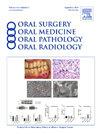Case report: intraosseous vascular malformation of the left maxilla
IF 2
3区 医学
Q2 DENTISTRY, ORAL SURGERY & MEDICINE
Oral Surgery Oral Medicine Oral Pathology Oral Radiology
Pub Date : 2025-02-04
DOI:10.1016/j.oooo.2024.11.011
引用次数: 0
Abstract
Clinical Presentation
A 63-year-old male patient presented with a lesion in the left maxilla showing progressive growth over 15 years, leading to concerns about facial distortion. An exophytic mass was observed clinically, extending from the mucogingival junction to the infraorbital area and the right maxillary first molar area. Radiographic findings revealed an ill-defined mixed density lesion involving the left maxillary sinus, anterior palate, and alveolus, with radiopaque contents resembling a periosteal reaction. Notably, the lesion extended buccally beyond the buccal cortex, causing soft tissue distention and erosion of the left lateral wall of the nasal fossa.
Differential Diagnosis
Given the clinical and radiographic features of the lesion, the differential diagnoses considered arteriovenous malformation and low-grade osteosarcoma. Correlation with observed mucosal discolorations and the presence of a bruit, further imaging using magnetic resonance imaging with and without contrast, and aspiration prior to biopsy were advised for a definitive diagnosis and to delineate the full extent of the lesion.
Diagnosis/Management
After incisional biopsy and osteoplasty, histopathologic evaluation confirmed the lesion as an intraosseous vascular malformation, characterized by an admixture of malformed vascular structures including capillaries, arteries, and venules, exhibiting abnormal vascular dilation. Intraosseous vascular malformations are a benign malformation of blood vessels with endothelial cells that do not have pathological proliferation. These lesions are typically seen in the first 3 decades of life in the mandible of female patients.
Conclusions
This case of an intraosseous vascular malformation, uniquely presenting in the maxilla of an older male patient, underscores the challenges associated with such lesions. The variable radiographic appearances can simulate malignant neoplasms, reinforcing the importance of comprehensive clinical, radiographic, and meticulous histopathological assessments for accurate diagnosis and management of this lesion.
求助全文
约1分钟内获得全文
求助全文
来源期刊

Oral Surgery Oral Medicine Oral Pathology Oral Radiology
DENTISTRY, ORAL SURGERY & MEDICINE-
CiteScore
3.80
自引率
6.90%
发文量
1217
审稿时长
2-4 weeks
期刊介绍:
Oral Surgery, Oral Medicine, Oral Pathology and Oral Radiology is required reading for anyone in the fields of oral surgery, oral medicine, oral pathology, oral radiology or advanced general practice dentistry. It is the only major dental journal that provides a practical and complete overview of the medical and surgical techniques of dental practice in four areas. Topics covered include such current issues as dental implants, treatment of HIV-infected patients, and evaluation and treatment of TMJ disorders. The official publication for nine societies, the Journal is recommended for initial purchase in the Brandon Hill study, Selected List of Books and Journals for the Small Medical Library.
 求助内容:
求助内容: 应助结果提醒方式:
应助结果提醒方式:


